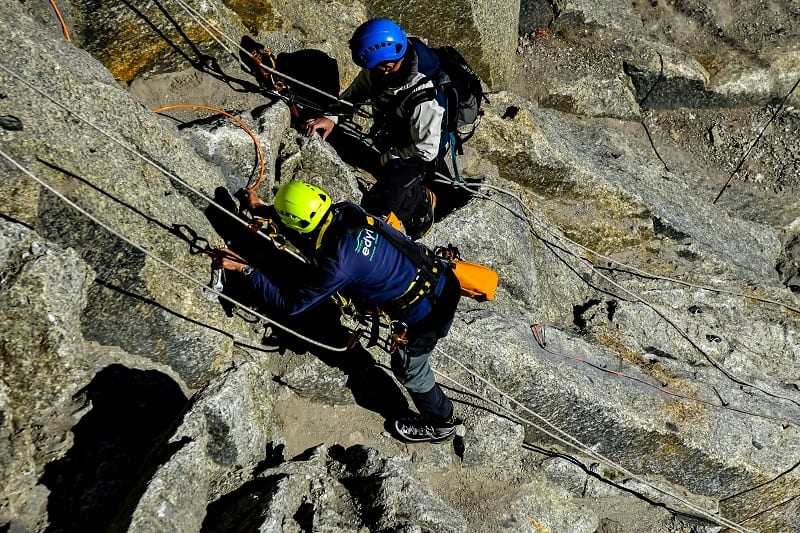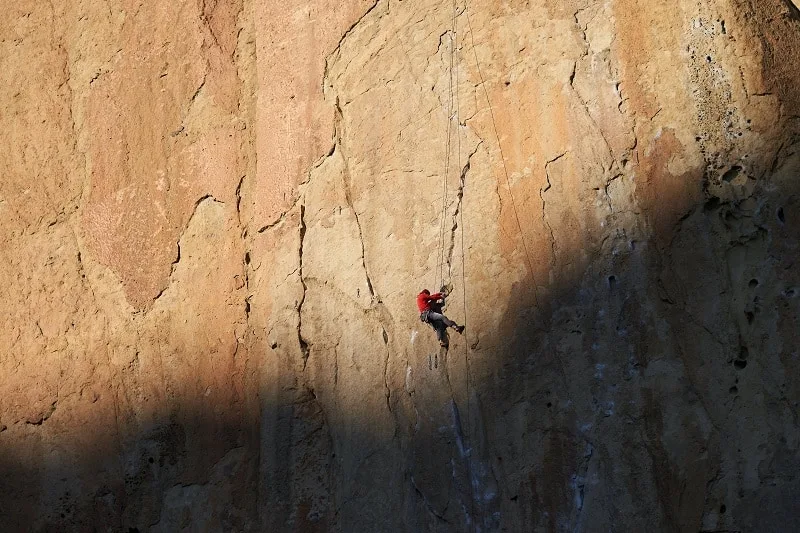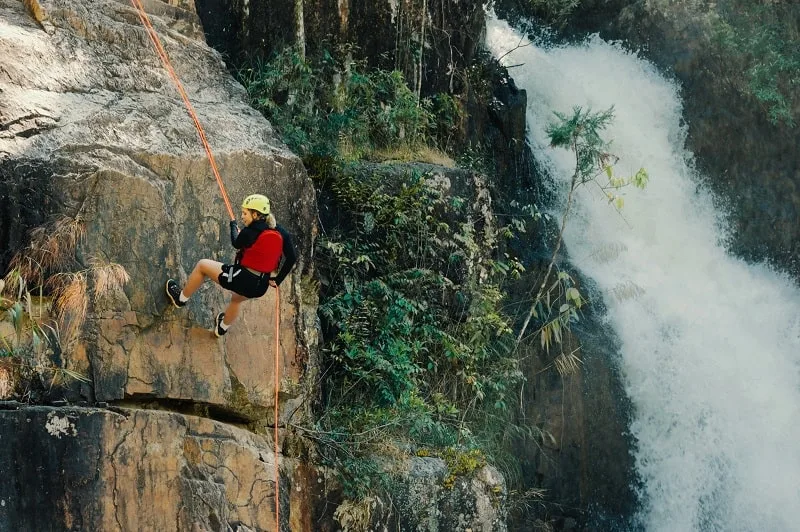Earth
Abseil vs Rappel
You might have come across the words ‘abseil’ or ‘rappel’ – both describing mountaineering or rock climbing. People often wonder if these words are interchangeable or have distinct characteristics that differentiate them.
Generally, rappelling and abseiling are both terms used for lowering yourself using a rope or cable as well as some sort of control mechanism. Anyone familiar with climbing jargon will understand what both words signify. Therefore, you cannot conclude with method or term is best.
On the surface of it, the difference is only geographical. Rappelling is the most frequently used in North America, but abseiling is widely used in the United Kingdom and other European nations.
However, the geographical difference stems from a deeper cultural variation. To guide you more about the origins of the terminology and why they differ, here is some research on climbing background:
Table of Content
- 1 Is Rappelling and Abseiling the Same?
- 2 What is Rappelling/Abseiling?
- 3 Mountaineering: Where it all Started
- 4 Which Terms are Used in Climbing Books?
- 5 Is Rappelling Less Popular than Abseiling
- 6 Who Calls it Rappelling and Who Calls it Abseiling?
- 7 Are There any Differences in Climbing Style?
- 8 FAQ:
- 9 Conclusion
Is Rappelling and Abseiling the Same?

Both words have a European origin, which makes sense given that rock climbing originated in Europe However, their linguistic heritage varies slightly, and so do their meanings.
Linguistic Heritage: “Abseiling” Origin
As abseil is derived from the German term abseilen, which translates directly to “to descend on a rope.” The phrase was most likely proposed in the early days of climbing, which began in Europe in the 1800s.
“Seil” separately translates to the word rope. It is also very common for Germans to use similar terms to describe an action done quickly or suddenly.
Linguistic Heritage: “Rappelling” Origin
Rappel is a French term. It originates from the French word “rappeler,” which literally means “to pull through.” However, rappel does not have a meaning in German. Unlike abseil, rappel in German means to recall or recede, according to Google translation.
Rappelling was probably first used to refer to the process of lowering oneself from a hill, which may be interpreted as ‘withdrawing’ from an ascent.
Geographical Differences
As I previously stated, the only true distinction between the two terms is their changing usage across the globe.
Rappelling is virtually solely used in the United States and Canada. Yet, any expert climber will know the word abseiling for what it is. Abseiling is the term used in the United Kingdom and Europe, particularly Germany, to describe someone lowering themselves using a rope.
Nonetheless, in other areas, the contrast is less obvious. For instance, the two are nearly interchangeable in Australia, New Zealand, and France.
What is Rappelling/Abseiling?

The definitions don’t clarify why one term is more prevalent than another based on where you are globally. To figure out how this occurred, we’ve included a brief overview of rock climbing, as well as our theory about why the two terms coexist.
Mountaineering: Where it all Started
What you now see as a recreational sport wasn’t as popular earlier. In fact, climbing a mountain or cliff wall was rare in old times. For centuries, mountains were seen as hazardous, sometimes holy areas with undisturbed tops. Many civilizations, like the Greeks, worshiped many gods or other celestial entities who they believed owned the mountain tops. As a result, folks who lived in these communities remained away from those peaks.
That began to alter around the 1500s when the Enlightenment swept over Europe and secularism became increasingly prevalent. The very first mountain expedition of Mount Blanc was achieved in 1786 by two climbers named Jacques Balmat and Michel-Gabriel Pacard. It was the highest mountain in the Alps. Therefore, it is still regarded as one of the most pivotal moments in mountain climbing.
Mountain climbing, often known as mountaineering or alpinism, became popular in Europe throughout the following two centuries. It was nothing less than a revolution. Famous peaks such as the Eiger and the Matterhorn were conquered, and government subsidies were awarded. Eventually, alpinist associations maintained detailed records of which mountains were reached. The passion expanded to far-flung mountain ranges like the Himalayas and the Andes.
Jean Charlet-Straton, a Chamonix mountain guide, was the first individual for his abseiling achievement. Charlet-Straton made multiple efforts at the un-summited top of Petit Dru in the late 1870s, ultimately reaching the summit in 1879. On these explorations, Charlet-Straton crafted the method of lowering himself through the use of rope. Little did he know this was expertise that he- and soon the rest of the world would use for the rest of their lives.
What we understand from this is how the term “abseiling” was used as a literal characterization of what Charlet-Straton was doing at the time. In reality, the term ‘rappel’ was never used to designate anything mountaineering-related until 1944. Apparently, Roger Frischon-Roche is said to have been the first to identify what Charlet-Straton devised as ‘rappelling.’
When did the term rappelling become popular? When abseiling had such a precise term, why was it employed at all? To understand this, we must first consider what was happening across the Atlantic Ocean while climbing gained popularity in Europe.
The American Influence on Climbing
While mountaineering flourished in Europe, achieving a pinnacle in 1953 when Sir Edmund Hillary ascended Mount Everest – mountaineering in America went a new trajectory.
Climbing in USA was popularized by icons like Royal Robbins, Warren Harding, and Jim Bridwell. This continued on the outskirts of society for many years until achieving widespread recognition in the 1980s. Rock climbing involved ascending steep vertical walls with one’s fingertips and toes. Who knew climbing that spawned out of a cultural revolt and a small campground in Yosemite Valley would soon take over the country.
In its initial periods, rock climbing did not have the distinction that mountaineering did. Climbing was seen as a niche pastime, whereas elite mountaineers earned public funds, lengthy trips, and societal acclaim. Climbers ignored the luxury and grandeur surrounding European Alpinism, ultimately preferring to develop their own sport—and a foreign vocabulary to go along with it.
Which came first?
Relative to rappelling, abseiling is a much older term from a historical standpoint. As previously stated, this was implemented by Jean Charlet-Straton during his ascension in 1876. Abseiling was renamed rappelling by Roger Frison-Roche in 1944, and it appears that the word stuck. While Roger changed the phrase somewhat, he did acknowledge the technique’s creator, thereby giving credit to the original ‘abseiler.’
It seems like the cultural divide is what created the two sides’ linguistic discrepancies. The cultural divide, however, not only created a language variation – but also showed the difference in attitude and perception that the terms are associated with.
Many mountaineers regard rock climbing as primarily a recreational activity that should be handled with extreme caution. Many extreme rock climbers, who viewed the activity as an exhilarating getaway, were frowned upon. As a result, many climbers saw mountaineers as arrogant and conceited.
It seems reasonable to me that this is the place where the two words began to diverge. Climbers in the United States were regularly required to rappel, descending themselves from the vast cliff faces of Yosemite Valley and other renowned climbing destinations. Mountaineers use rappelling less frequently, but it is still an essential component of their skill set.
History shows how the climbers abandoned the terminology of abseiling in favor of the much more recently invented ‘rappel’. They did this to express what they were doing as part of their disdain towards mountaineering and its elitist attitude.
Which Terms are Used in Climbing Books?
While it is difficult to conclude which term is more popular in real life, books give a clearer answer. According to sources, English authors prefer the term rappelling over abseiling. In fact, it appears that this version is utilized up to 65 percent more frequently, putting it in the lead.
The specific reason for this, however – remains unknown. Again it may possibly be stemming from the origin and nationality of the author himself or the experiences he is describing.
Is Rappelling Less Popular than Abseiling
Comparing popularity for both terms is quite tricky. What we can do is measure relative popularity according to specific locations.
Rappelling, for example, is primarily prevalent in the United States. In the United Kingdom, and much of Europe. However, it is known as abseiling. That being said, people in the UK will easily comprehend what you’re talking about if you do call it rappelling. It is another thing that the climbers like to refer to it as abseiling.
Even though these terminologies are inextricably related to people’s heritage, I’ve seen Americans also refer to rappelling as abseiling and vice versa. This conduct, I believe, is linked to the area where this activity was learned. It also has something to do with their own experiences and the nationality of their instructors.
Who Calls it Rappelling and Who Calls it Abseiling?

The main difference between the terms rappelling and abseiling is subject to cultural variances. In many European countries, abseiling is a famous phrase. However, in the United States, rappelling is used. The terms “rappel” and “abseil” are nearly interchangeable in certain countries, such as New Zealand and Canada.
Are There any Differences in Climbing Style?
Now that you know that the primary difference is the usage that greatly varies culture to culture or location to location. The next big question is – are there any differences in climbing style? If yes, are there any specific tools or gear used for either of them?
Here are a few of the best climbing styles:
Different Rappelling Climbing Styles
A standard rappel is when you descend from a vertical structure with your backside to the land and your legs against the ledge. A harness will have your belay device attached to your waist, and you’ll utilize it to produce resistance as you descend. It’s suitable for novices who are learning to rappel; You have complete control over your drop speed.
An Australian rappel is a face-first descent to the ground. The rope is attached to your midsection and your legs against the ledge you’re lowering from. This approach allows you to gain considerably more pace than a standard rappel; In fact, you may even race down if you want.
This, however, creates some difficulties since you’ll be continually fighting the rope as it tries to draw you back into a traditional belaying posture. You also risk having loose clothes or things trapped in the device.
Hanging free rappel is when you usually drop a length of rope while wearing your gear and control the descent with your brake hand. The only distinction between this and a standard rappel is that you’re not braced against a structure; instead, you’re swinging in free space while descending.
The Australian variant of a hanging rappel is known as the Military Rappel. Military Rappels were initially created to assist Australian soldiers in lowering to the ground while still striking. The military rappel allows you to suspend in mid-air while dropping quickly and efficiently to the ground. It’s quick, hazardous, and incredibly thrilling.
A Simmul Rappel is a descent in which you and your companion fall from the same piece of rope, balancing each other’s weight out. This is the way to go when you need to go down fast but don’t want to leave your stuff behind. It makes sense to adopt this advanced approach when descending a tight ridge or spire with no anchor points.
A fireman’s belay is a common approach for lowering someone who isn’t very skilled in going down from a rappel. One person takes control of the rappeler’s cables and waits at the bottom of whatever you’re rappelling. When they pull the rope down, friction is created inside the system, bringing the rappeler to a stop.
The many variations of rappelling are beneficial in different situations. It depends on, and you should only use them after practicing and learning them in a safe setting.
Different Abseiling Climbing Styles

Rescue type abseiling is the most basic type of abseiling. One abseiler utilizes a rope attached to the top of a cliff to fall to the bottom using their own strength. Abseilers use a belay device linked to a harness around their waist to regulate their pace.
Abseilers grasp the rope with the guiding hand above and the break hand below the belay device to control their movement, while the tension created by the belay device ensures that they do not descend too rapidly.
Also known as spider rappelling, tandem abseiling entails you and a companion being hooked to the same length of string and abseiling down next to each other.
Either both abseilers can be belayed from the top, or a more expert abseiler can utilize this approach to assist a less competent partner get down – using the same belay gear. The trick to this abseiling technique is to make sure you’re both taking steps at the same time and coordinating your descent!
Leaders and guides can descend with novice abseilers using the releasable abseil – a safety strategy. A munter mule hitch is used to secure a rope about double the length of the fall. The person lowers on a single strand of cable that is segregated.
If the person becomes trapped halfway down, the instructor can use the hitch as a belay mechanism to free the other string and drop the person to the bottom. This is best if the person gets nervous or gets their garments or hair caught in the belay device.
The fourth type is fan descender, where the cable you abseil with is wrapped around a drum that regulates your pace of fall for you, throwing the cable out at a consistent speed. In a descender, tension is generated by employing a fan to slow you down by using wind resistance against big fan blades.
FAQ:
1. What is military rappelling?
Military rappelling, also referred to as Australian rappelling, is when you drop yourself face-first with the help of a belay device clipped to the back of your harness. It enables the person rappelling to more easily see the ground beneath them.
2. Is rappelling dangerous?
It can undoubtedly be. It is not as dangerous as rock climbing. There can be ropes that jam or equipment failure. If you, you will be injured badly depending on the height of the fall.
3. Is rappelling a sport?
Rappelling/Abseiling can be considered a sports activity. It is a sport where you scale down a mountain face or a crag. It is a great experience that gives you a little bit of a rush going down.
4. Can two people rappel simultaneously?
Simul-rapping is a complex technique in which two people rappel one rope simultaneously with one hiker’s weight counterbalancing the other.
5. What equipment do you need to rappel?
Technically you can rappel with only a rape, and that is how it was initially introduced. However, as time passed, several pieces of equipment have been created to make the climb much safer. Core rappelling gear consists of helmets, protective clothing, harnesses, gloves, carabiners, belay devices, and climbing shoes.
Conclusion
The techniques of abseiling and rappelling are more or less the same. They are both used to come down after a climb – whether done as a sports activity or a necessity. The only difference is that they come from distinct backgrounds and first appeared at separate eras in the history of rock climbing and mountaineering chronology.
Rappelling and abseiling can mostly be justified through geographical differences and cultural barriers. It’s logical for separate jargon to evolve when 2 different activities are conducted in different world regions, and there is a cultural divide. However, from a linguistic point of view – the English language doesn’t provide much distinction.


